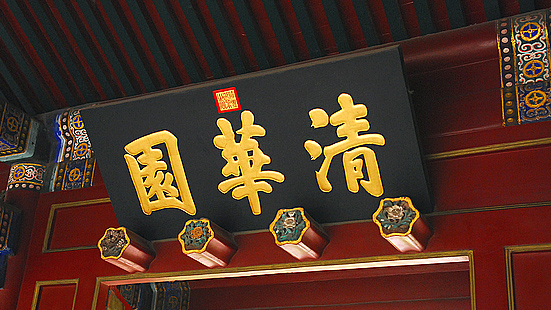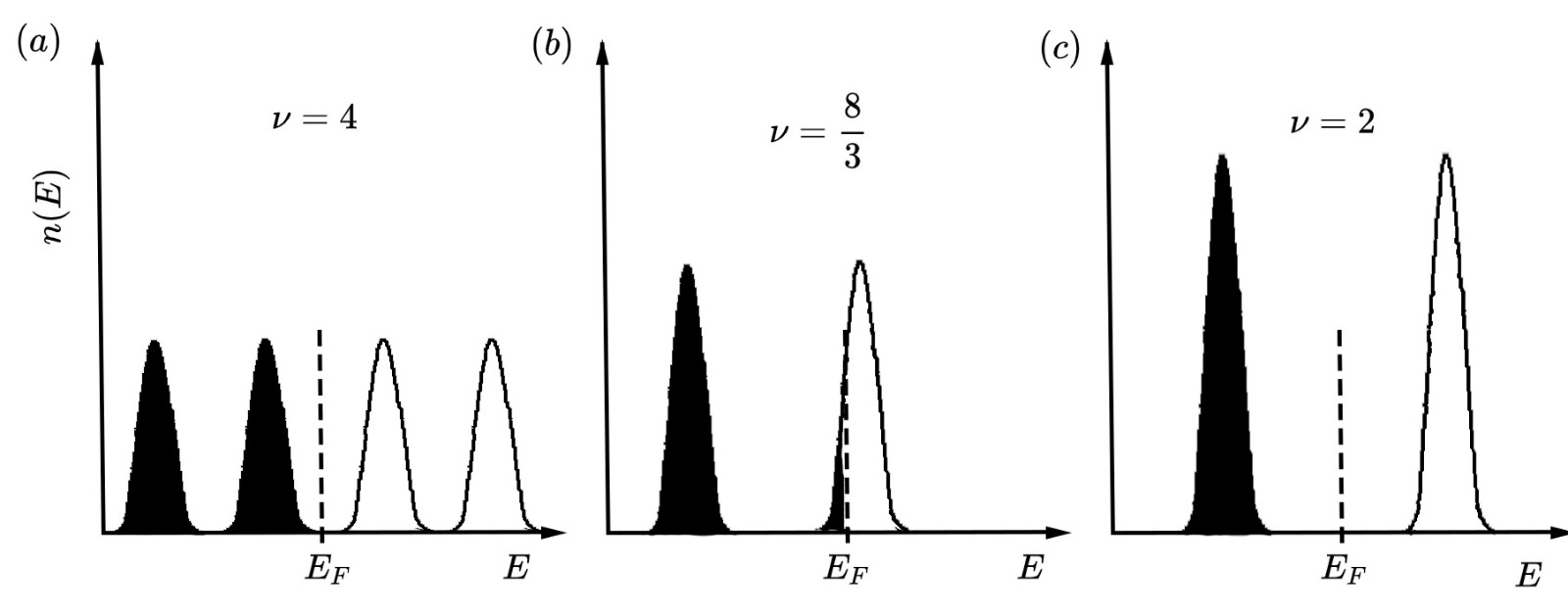|
Quantum Anomalous Hall Effect
Quantum anomalous Hall effect (QAHE) is the "quantum" version of the anomalous Hall effect. While the anomalous Hall effect requires a combination of magnetic polarization and spin-orbit coupling to generate a finite Hall voltage even in the absence of an external magnetic field (hence called "anomalous"), the quantum anomalous Hall effect is its quantized version. The Hall conductivity acquires quantized values proportional to integer multiples of the von Klitzing constant (e^2/h) (also called conductance quantum). In this respect the QAHE is similar to the quantum Hall effect. The integer here is equal to the Chern number which arises out of topological properties of the material band structure. These effects are observed in systems called quantum anomalous Hall insulators (also called Chern insulators). The effect was observed experimentally for the first time in 2013 by a team led by Xue Qikun at Tsinghua University. See also *Quantum Hall effect *Hall effect The Hall ... [...More Info...] [...Related Items...] OR: [Wikipedia] [Google] [Baidu] |
Hall Effect
The Hall effect is the production of a voltage, potential difference (the Hall voltage) across an electrical conductor that is wikt:transverse, transverse to an electric current in the conductor and to an applied magnetic field wikt:perpendicular, perpendicular to the current. It was discovered by Edwin Hall in 1879. The ''Hall coefficient'' is defined as the ratio of the induced electric field to the product of the current density and the applied magnetic field. It is a characteristic of the material from which the conductor is made, since its value depends on the type, number, and properties of the charge carriers that constitute the current. Discovery Wires carrying current in a magnetic field experience a mechanical force perpendicular to both the current and magnetic field. In the 1820s, André-Marie Ampère observed this underlying mechanism that led to the discovery of the Hall effect. However it was not until a solid mathematical basis for electromagnetism was system ... [...More Info...] [...Related Items...] OR: [Wikipedia] [Google] [Baidu] |
Spin–orbit Interaction
In quantum mechanics, the spin–orbit interaction (also called spin–orbit effect or spin–orbit coupling) is a relativistic interaction of a particle's spin with its motion inside a potential. A key example of this phenomenon is the spin–orbit interaction leading to shifts in an electron's atomic energy levels, due to electromagnetic interaction between the electron's magnetic dipole, its orbital motion, and the electrostatic field of the positively charged nucleus. This phenomenon is detectable as a splitting of spectral lines, which can be thought of as a Zeeman effect product of two effects: the apparent magnetic field seen from the electron perspective due to special relativity and the magnetic moment of the electron associated with its intrinsic spin due to quantum mechanics. For atoms, energy level splitting produced by the spin–orbit interaction is usually of the same order in size as the relativistic corrections to the kinetic energy and the zitterbewegung ... [...More Info...] [...Related Items...] OR: [Wikipedia] [Google] [Baidu] |
Conductance Quantum
The conductance quantum, denoted by the symbol , is the quantized unit of electrical conductance. It is defined by the elementary charge ''e'' and Planck constant ''h'' as: : G_0 = \frac = 4 \alpha \epsilon_0 c = It appears when measuring the conductance of a quantum point contact, and, more generally, is a key component of the Landauer formula, which relates the electrical conductance of a quantum conductor to its quantum properties. It is twice the reciprocal of the von Klitzing constant (2/''R''K). Note that the conductance quantum does not mean that the conductance of any system must be an integer multiple of ''G''0. Instead, it describes the conductance of two quantum channels (one channel for spin up and one channel for spin down) if the probability for transmitting an electron that enters the channel is unity, i.e. if transport through the channel is ballistic. If the transmission probability is less than unity, then the conductance of the channel is less than ''G''0. ... [...More Info...] [...Related Items...] OR: [Wikipedia] [Google] [Baidu] |
Quantum Hall Effect
The quantum Hall effect (or integer quantum Hall effect) is a quantized version of the Hall effect which is observed in two-dimensional electron systems subjected to low temperatures and strong magnetic fields, in which the Hall resistance exhibits steps that take on the quantized values : R_ = \frac = \frac , where is the Hall voltage, is the channel current, is the elementary charge and is the Planck constant. The divisor can take on either integer () or fractional () values. Here, is roughly but not exactly equal to the filling factor of Landau levels. The quantum Hall effect is referred to as the integer or fractional quantum Hall effect depending on whether is an integer or fraction, respectively. The striking feature of the integer quantum Hall effect is the persistence of the quantization (i.e. the Hall plateau) as the electron density is varied. Since the electron density remains constant when the Fermi level is in a clean spectral gap, this situation corre ... [...More Info...] [...Related Items...] OR: [Wikipedia] [Google] [Baidu] |
Chern Class
In mathematics, in particular in algebraic topology, differential geometry and algebraic geometry, the Chern classes are characteristic classes associated with complex vector bundles. They have since become fundamental concepts in many branches of mathematics and physics, such as string theory, Chern–Simons theory, knot theory, and Gromov–Witten invariants. Chern classes were introduced by . Geometric approach Basic idea and motivation Chern classes are characteristic classes. They are topological invariants associated with vector bundles on a smooth manifold. The question of whether two ostensibly different vector bundles are the same can be quite hard to answer. The Chern classes provide a simple test: if the Chern classes of a pair of vector bundles do not agree, then the vector bundles are different. The converse, however, is not true. In topology, differential geometry, and algebraic geometry, it is often important to count how many linearly independent sect ... [...More Info...] [...Related Items...] OR: [Wikipedia] [Google] [Baidu] |
Electronic Band Structure
In solid-state physics, the electronic band structure (or simply band structure) of a solid describes the range of energy levels that electrons may have within it, as well as the ranges of energy that they may not have (called ''band gaps'' or ''forbidden bands''). Band theory derives these bands and band gaps by examining the allowed quantum mechanical wave functions for an electron in a large, periodic lattice of atoms or molecules. Band theory has been successfully used to explain many physical properties of solids, such as electrical resistivity and optical absorption, and forms the foundation of the understanding of all solid-state devices (transistors, solar cells, etc.). Why bands and band gaps occur The formation of electronic bands and band gaps can be illustrated with two complementary models for electrons in solids. The first one is the nearly free electron model, in which the electrons are assumed to move almost freely within the material. In this model, the ... [...More Info...] [...Related Items...] OR: [Wikipedia] [Google] [Baidu] |
Xue Qikun
Xue Qikun (; born December 1963) is a Chinese physicist. He is a professor of Tsinghua University, Beijing. He has done much work in condensed matter physics, especially on superconductors and topological insulators. In 2013, Xue was the first to achieve the quantum anomalous Hall effect (QAHE), an unusual orderly motion of electrons in a conductor, in his laboratory at Tsinghua University. Xue is a member of the Chinese Academy of Sciences, vice president for research of Tsinghua University, and director of State Key Lab of Quantum Physics. In 2016, he was one of the first recipients of the new Chinese Future Science Prize for experimental discovery of high-temperature superconductivity at material interfaces and the QAHE. This award has been described as "China's Nobel Prize". Career Xue earned his PhD from the Institute of Physics, Chinese Academy of Sciences in 1994. From 1994 to 2000, he worked as a research associate at Institute for Materials Research, Tohoku Universit ... [...More Info...] [...Related Items...] OR: [Wikipedia] [Google] [Baidu] |
Tsinghua University
Tsinghua University (THU) is a public university in Haidian, Beijing, China. It is affiliated with and funded by the Ministry of Education of China. The university is part of Project 211, Project 985, and the Double First-Class Construction. It is also a member in the C9 League. Tsinghua University's campus is in northwest Beijing, on the site of the former imperial gardens of the Qing dynasty. The university has 21 schools and 59 departments, with faculties in science, engineering, humanities, law, medicine, history, philosophy, economics, management, education, and art. History Early 20th century (1911–1949) Tsinghua University was established in Beijing during a tumultuous period of national upheaval and conflicts with foreign powers which culminated in the Boxer Rebellion, an uprising against foreign influence in China. After the suppression of the revolt by a foreign alliance including the United States, the ruling Qing dynasty was required to pay inde ... [...More Info...] [...Related Items...] OR: [Wikipedia] [Google] [Baidu] |
Quantum Hall Effect
The quantum Hall effect (or integer quantum Hall effect) is a quantized version of the Hall effect which is observed in two-dimensional electron systems subjected to low temperatures and strong magnetic fields, in which the Hall resistance exhibits steps that take on the quantized values : R_ = \frac = \frac , where is the Hall voltage, is the channel current, is the elementary charge and is the Planck constant. The divisor can take on either integer () or fractional () values. Here, is roughly but not exactly equal to the filling factor of Landau levels. The quantum Hall effect is referred to as the integer or fractional quantum Hall effect depending on whether is an integer or fraction, respectively. The striking feature of the integer quantum Hall effect is the persistence of the quantization (i.e. the Hall plateau) as the electron density is varied. Since the electron density remains constant when the Fermi level is in a clean spectral gap, this situation corre ... [...More Info...] [...Related Items...] OR: [Wikipedia] [Google] [Baidu] |
Hall Effect
The Hall effect is the production of a voltage, potential difference (the Hall voltage) across an electrical conductor that is wikt:transverse, transverse to an electric current in the conductor and to an applied magnetic field wikt:perpendicular, perpendicular to the current. It was discovered by Edwin Hall in 1879. The ''Hall coefficient'' is defined as the ratio of the induced electric field to the product of the current density and the applied magnetic field. It is a characteristic of the material from which the conductor is made, since its value depends on the type, number, and properties of the charge carriers that constitute the current. Discovery Wires carrying current in a magnetic field experience a mechanical force perpendicular to both the current and magnetic field. In the 1820s, André-Marie Ampère observed this underlying mechanism that led to the discovery of the Hall effect. However it was not until a solid mathematical basis for electromagnetism was system ... [...More Info...] [...Related Items...] OR: [Wikipedia] [Google] [Baidu] |




